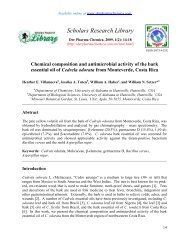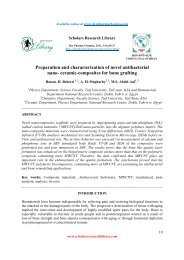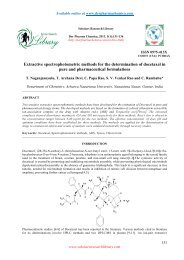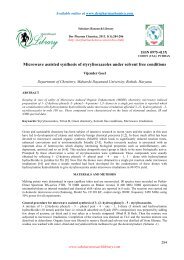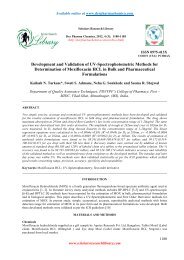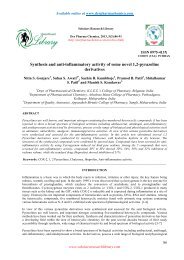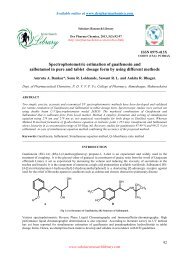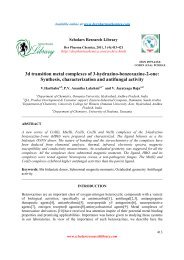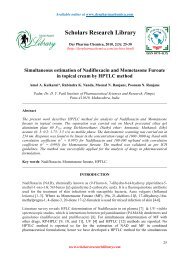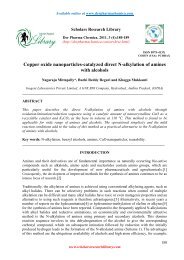Removal of Chromium (VI) from Waste Waters Using Leaves ...
Removal of Chromium (VI) from Waste Waters Using Leaves ...
Removal of Chromium (VI) from Waste Waters Using Leaves ...
Create successful ePaper yourself
Turn your PDF publications into a flip-book with our unique Google optimized e-Paper software.
Available online at www.derpharmachemica.com<br />
Scholars Research Library<br />
Der Pharma Chemica, 2012, 4 (2):664-673<br />
(http://derpharmachemica.com/archive.html)<br />
ISSN 0975-413X<br />
CODEN (USA): PCHHAX<br />
<strong>Removal</strong> <strong>of</strong> <strong>Chromium</strong> (<strong>VI</strong>) <strong>from</strong> <strong>Waste</strong> <strong>Waters</strong> <strong>Using</strong> <strong>Leaves</strong> Powders <strong>of</strong><br />
Justicia adhatoda, Cissus quadrangularis, Soapnut Acacia<br />
K. P.C. Sekhar, R. V. Vishnu Babu, D. Srividhya, K. Ravindhranath*<br />
Department <strong>of</strong> Engg. Chemistry and Post Graduate Chemistry, Bapatla Engineering College,<br />
Bapatla, Guntur Dt., A.P.<br />
______________________________________________________________________________<br />
ABSTRACT<br />
The sorption characteristics <strong>of</strong> bio-adsorbents derived <strong>from</strong> leaves <strong>of</strong> Justicia adhatoda , Cissus quadrangularis,<br />
Soapnut Acacia toward <strong>Chromium</strong> (<strong>VI</strong>) ions , have been explored by varying the physicochemical parameters such<br />
as pH, sorbent concentration and time <strong>of</strong> equilibration. Percentage <strong>of</strong> extraction <strong>of</strong> <strong>Chromium</strong> (<strong>VI</strong>) is found to be<br />
pH sensitive and also depends on time <strong>of</strong> equilibration and sorbent concentration. Conditions have been optimized<br />
for the maximum extraction <strong>of</strong> <strong>Chromium</strong> (<strong>VI</strong>); it is found to be: 88.0% with Justicia adhatoda leaves powders;<br />
88.0% with Cissus quadrangularis leaves powder, and 84.0% with Soapnut Acacia leaves powders. Tenfold excess<br />
<strong>of</strong> common cation ions are found to have synergistic effect in enhancing the % removal <strong>of</strong> <strong>Chromium</strong>(<strong>VI</strong>). SO4 2- ,<br />
PO4 3- and CO3 2- are interfering in the order: PO4 3- > SO4 2- > CO3 2- . NO3 - , Cl – and F - have marginal interference.<br />
The methodologies developed in this work are remarkably successful in removing the <strong>Chromium</strong>(<strong>VI</strong>) <strong>from</strong> industrial<br />
effluents and polluted lake samples.<br />
Key Words: <strong>Removal</strong> <strong>of</strong> <strong>Chromium</strong> (<strong>VI</strong>), Bio-sorption, Herbal plants, Applications.<br />
______________________________________________________________________________<br />
INDTRODUCTION<br />
Toxic chromium salts are extensively used in various industries such as leather industry metallurgical industries and<br />
in the manufacture <strong>of</strong>, paints, inks, wood preservatives, photographic materials, textile , rubber, ceramics and in<br />
fungicides[1 -3]. The effluents <strong>of</strong> these industries having have to be treated for the complete removal <strong>of</strong> <strong>Chromium</strong><br />
ions before they are discharged into environment. If rigorous scientific methods <strong>of</strong> disposal are not followed, there<br />
arises a potential danger <strong>of</strong> entrance <strong>of</strong> <strong>Chromium</strong> ion into the nearby water bodies. The <strong>Chromium</strong> ions being nondegradable<br />
in nature enter into the biological systems, get accumulated in the food chains in unspecific compounds<br />
inside the cells <strong>of</strong> living organisms causing significant threat to aquatic life [3-6].<br />
Of the two states <strong>of</strong> <strong>Chromium</strong>, hexavalent ions are many folds dangerous then trivalent ions It is due to its easy<br />
penetration into biological membranes resulting in health hazards [6] such as skin disorders, respiratory track<br />
problems, lung carcinoma, acute tubular necrosis <strong>of</strong> kidney and even death in extreme cases [2,3,6].<br />
The permissible potable limit <strong>of</strong> <strong>Chromium</strong> in drinking waters is 0.1 ppm and in irrigation waters is 100 ppm as per<br />
USEPA [2, 3, and 6].<br />
www.scholarsresearchlibrary.com<br />
664
K. Ravindhranath et al Der Pharma Chemica, 2012, 4 (2):664-673<br />
_____________________________________________________________________________<br />
Methodologies have been developed in controlling <strong>Chromium</strong>, based on Chemical reduction [5,7-9],<br />
Flocculation[7], Electrolysis and Electroplating [10,11], Nan<strong>of</strong>iltration[12], bioaccumulation [13], ion exchange[14],<br />
adsorption on silica composites [15,16], activated carbons[17-19], fly Ash [20], modified zeolites [21,22], bone<br />
charcoal [23] and microbes [24] .A number <strong>of</strong> patents are also found in literature [25]. These techniques suffer <strong>from</strong><br />
one or other disadvantages like costly, incomplete metal removal, high reagent and energy requirements and<br />
generation <strong>of</strong> toxic sludges or other toxic waste products that require careful disposal. An efficient, simple, ec<strong>of</strong>riendly<br />
and economical methods are still eluding the environmental researchers.<br />
In this contest bioadsorbents derived <strong>from</strong> Lignocelluloses materials such as leaves, barks, biomasses, and other<br />
agricultural wastes in controlling pollution problems [26-37] are proving to be potential alternative to the traditional<br />
and conventional methods. Many biomaterials have been probed for their sorption abililties towards <strong>Chromium</strong> ions.<br />
Methods have been developed using coconut fiber [28], eucalyptus bark [30] , maple sawdust [31], Hevea<br />
brasilinesis sawdust activated carbon [32] , waste tealeaves, rice husk [33] and Neem Sawdust [35] . Comparative<br />
studies have also been made using different adsorbent in effectively controlling the <strong>Chromium</strong> in waters [36, 37]. A<br />
review <strong>of</strong> literature using microbes in extracting <strong>Chromium</strong> is available in literature [24].<br />
While we are making some pilot studies in exploring the sorption abilities <strong>of</strong> powders <strong>of</strong> leaves <strong>of</strong> herbal plants for<br />
the removal <strong>of</strong> <strong>Chromium</strong> (<strong>VI</strong>) <strong>from</strong> polluted waters, we noticed strong affinity between <strong>Chromium</strong> ions and leaves<br />
powders <strong>of</strong> Justicia adhatoda,Cissus quadrangulari and Soapnut Acacia. The present work is a thorough study <strong>of</strong><br />
sorption characteristics <strong>of</strong> these biomaterials towards <strong>Chromium</strong>(<strong>VI</strong>) in developing a simple and versatile<br />
procedures for its removal .<br />
MATERIALS AND METHODS<br />
(A) Chemicals:<br />
All chemicals used were <strong>of</strong> analytical grade. 50 ppm stock solution <strong>of</strong> <strong>Chromium</strong> (<strong>VI</strong>) was prepared using A.R.<br />
Potassium Dichromate in double distilled water. 6N Sulphuric acid and 0.25% <strong>of</strong> Diphenyl carbazide in 50% <strong>of</strong><br />
acetone were employed.<br />
(B)Adsorbents: The sorption nature <strong>of</strong> powders <strong>of</strong> leaves <strong>of</strong> Justicia adhatoda, Cissus quadrangularis and<br />
Soapnut Acacia for <strong>Chromium</strong> (<strong>VI</strong>) have been studied in this work .<br />
Justicia adhatoda Cissus quadrangularis Soapnut Acacia<br />
Fig : 1: Plants showing affinity towards <strong>Chromium</strong> (<strong>VI</strong>)<br />
Justicia adhatoda is a herbal plant blossoms in cold season and is called Vaidyamata Singhee in Sanskrit. It belongs<br />
Acanthaceae family and grows wild in abundance all over India. It is reported to have many medicinal values<br />
especially related to heart ailments.Cissus quadrangularis is a perennial plant <strong>of</strong> the grape family and is commonly<br />
known as Veldt Grape or Devil's Backbone. It is native to India and grows to a height <strong>of</strong> 1.5 m.It belongs to<br />
Vitaceae family. It has many therapeutic values in curing fractured bones, asthma and cardiac problems. Its products<br />
also reported to be useful in curing leprosky,ulcers, tumours and skin diseases. Soapnut Acacia is herb blongs to<br />
Mirnosaceae family and is well grown in costal planes <strong>of</strong> south India. Its plant material are used used as<br />
astringentand cleanser and also in the preparation some traditional Tribal Formulations. It is endowed with<br />
medicinal values in curing skin diseases, renal calculi, vesicle calculi, hemorrhoids, leprosy, abscesses, eczema and<br />
biliousness.<br />
www.scholarsresearchlibrary.com<br />
665
K. Ravindhranath et al Der Pharma Chemica, 2012, 4 (2):664-673<br />
_____________________________________________________________________________<br />
The leaves <strong>of</strong> Justicia adhatoda, Cissus quadrangularis and Soapnut Acacia were cut, washed with tap water<br />
followed by distilled water and then sun dried. The dried materials were powdered to a fine mesh <strong>of</strong> size:
K. Ravindhranath et al Der Pharma Chemica, 2012, 4 (2):664-673<br />
_____________________________________________________________________________<br />
will not be any further adsorption after certain time <strong>of</strong> equilibration time (vide Graph Nos. A: 1-3). As for example,<br />
in the case <strong>of</strong> leaves <strong>of</strong> Justicia adhatoda, at pH: 2 and at sorption conc. <strong>of</strong> 2.5gm/500 ml, the % <strong>of</strong> extraction is :<br />
28.0% at 0.5 hr; 44.0% at 1.0 hr; 64.0% at 1.5 hr; 84.0% at 2.0 hr; 88.0% at 2.5 hr; 88.0% at 3.0 hr; 88.0 % at<br />
periods more than 3.0 hrs. (Vide Graph No.: A: 1). The trend is same in rest <strong>of</strong> the sorbents (vide Graph No.: A:<br />
2&3).<br />
3. Effect <strong>of</strong> pH: pH conditions <strong>of</strong> sorption experiment are found to play a major role. As pH decreases, percentage<br />
<strong>of</strong> extraction is found to be increasing (Vide Graph: B: 1). As for example, with the leaves powders <strong>of</strong> Justicia<br />
adhatoda, % <strong>of</strong> extractability is found to be : 36.0% at pH: 10, 44.0% at pH: 8, 52.0% at pH: 6, 72.0% at pH: 4 and<br />
88.0% at pH: 2 after an equilibration time <strong>of</strong> 2.5 hrs with sorbent concentration <strong>of</strong> 2.5 gm/500 ml. With the leaves<br />
powders <strong>of</strong> Cissus quadrangularis, % <strong>of</strong> extractability is found to be 16.0 % at pH:10, 20.0% at pH:8, 28.0% at<br />
pH:6, 48.0% at pH:4 and 88.0% at pH: 2 after an equilibration time <strong>of</strong> 2.0 hrs and with the sorbent concentration<br />
<strong>of</strong> 2.5 gm/500 ml . In the case <strong>of</strong> leaves powders <strong>of</strong> Soapnut Acacia, % <strong>of</strong> extractability is found to be 20.0% at<br />
pH:10, 24.0% at pH:8, 36.0% at pH:6, 76.0% at pH:4 and 84.0 % at pH:2 after an equilibration time <strong>of</strong> 2.0 hrs and<br />
sorbent concentration <strong>of</strong> 2.0 gm/ 500 ml.<br />
4. Sorbent Concentration: The sorbent dosage needed for the maximum extraction <strong>of</strong> Chromate at pH: 2 and at<br />
optimum equilibration times is found to be 2.5 gram/500 ml for the leaves powders <strong>of</strong> Justicia adhatoda; 2.5<br />
gm/500 ml for leaves powders <strong>of</strong> Cissus quadrangularis ; 2.0 gm/ 500 ml for leaves powders <strong>of</strong> Soapnut Acacia<br />
(vide Graph No.: C:1)<br />
5. The % <strong>of</strong> maximum extractability <strong>of</strong> <strong>Chromium</strong> (<strong>VI</strong> ) at optimum conditions <strong>of</strong> pH and equilibration time are<br />
found to be 88.0%, 88.0% and 84.0% in the case <strong>of</strong> leaves powders <strong>of</strong> Justicia adhatoda, Cissus quadrangularis,<br />
Soapnut Acacia respectively (vide Graph Nos.A:1-3).<br />
6. Interfering Ions: The extractabilities <strong>of</strong> Chromate ions in presence <strong>of</strong> tenfold excess <strong>of</strong> common ions found in<br />
natural waters namely, Sulphate, Nitrate, Chloride, Phosphate, Fluoride, Carbonate, Calcium, Magnesium, Copper,<br />
Zinc, Nickel and Iron ions have been studied. The results are presented in Table No. 1.<br />
• Cations:<br />
It is interesting to note that the extractability is markedly enhanced in presence <strong>of</strong>. cations ions. The tenfold excess<br />
<strong>of</strong> Ca 2+ , Mg 2+ , Cu 2+ , Zn 2+ , Ni 2+ and Fe 2+ ions, is found to increase the % <strong>of</strong> exctraction <strong>of</strong> <strong>Chromium</strong> respectively<br />
<strong>from</strong> 88.0% to 100.0%, 94.3%, 97.8% ,96.1%, 97.9% and 99.1 % respectively with the leaves powders <strong>of</strong> Justicia<br />
adhatoda (vide Table No.: 1:column No.3) ; <strong>from</strong> 88.0% to 99.3%, 93.8%, 97.2% 95.5%, 97.2% and 98.4%<br />
respectively with the leaves powders <strong>of</strong> Cissus quadrangularis (vide Table No:1: Column No. 4)); and <strong>from</strong> 84.0%<br />
to 95.7% , 88.7% , 92.3 % , 91.6%, 92.4% and 94.8% respectively with leaves powders <strong>of</strong> Soapnut Acacia (vide<br />
Table No. 1: Colum No.5).<br />
Further, it is interesting to note that the extent <strong>of</strong> interference is found to be in the expected order:<br />
Ca 2+ > Fe 2+ >Ni 2+ ~ Cu 2+ > Zn 2+ >Mg 2+ .<br />
• Anions:<br />
• Phosphate, Sulphate and Carbonate are found to be interfering and the extent <strong>of</strong> interference is found to be in<br />
the order: PO4 3- > SO4 2- > CO3 2- .<br />
• Ten fold excess <strong>of</strong> PO4 3- is found to reduce % <strong>of</strong> extraction <strong>from</strong> 88.0% to 62.3% in the case <strong>of</strong> leaves <strong>of</strong><br />
Justicia adhatoda; 88.0% to 61.2% with leaves powder <strong>of</strong> Cissus quadrangularis ; 84.0 % to 60.9 % with leaves<br />
powder <strong>of</strong> SoapnutAcacia (vide S. No. 5 <strong>of</strong> Table Nos:1)<br />
• Tenfold excess <strong>of</strong> SO4 2- is found effect the % extraction <strong>from</strong> 88.0% to 64.4 % in the case <strong>of</strong> powder <strong>of</strong> leaves <strong>of</strong><br />
Justicia adhatoda as sorbent; 88.0% to 63.6% with leaves powder <strong>of</strong> Cissus quadrangularis; 84.0 % to 62.9 % with<br />
leaves powder <strong>of</strong> Soapnut Acacia (vide S. No. 2 <strong>of</strong> Table Nos:1).<br />
www.scholarsresearchlibrary.com<br />
667
K. Ravindhranath et al<br />
Der Pharma Chemica, 2012, 4 (2):664-673 (2):<br />
_____________________________________________________________________________<br />
__________________________________________________________<br />
• CO3 2- in tenfold excess, is also found to decrease the % <strong>of</strong> extraction <strong>from</strong> 88.0% to 71.9%<br />
powder <strong>of</strong> leaves <strong>of</strong> Justicia adhatoda; adhatoda 88.0% to 71.1% with leaves powder <strong>of</strong> Cissus quadrangularis<br />
70.2 % with leaves powder <strong>of</strong> Soapnut Acacia (vide S. No. 7 <strong>of</strong> Table Nos:1).<br />
Ten fold excess <strong>of</strong> Nitrate , Chloride and Fluoride and are found to have marginal<br />
extractability <strong>of</strong> <strong>Chromium</strong> in all the sorbents <strong>of</strong> interest (vide Sl. Nos. 3,4&6 <strong>of</strong> Table No. 1).<br />
natural expected order <strong>of</strong> interference: NO3 NO<br />
- > Cl - > F - <strong>from</strong> 88.0% to 71.9% in the case <strong>of</strong><br />
Cissus quadrangularis; 84.0 % to<br />
interference with the % <strong>of</strong><br />
Nos. 3,4&6 <strong>of</strong> Table No. 1).Even then, the<br />
is followed.<br />
DISCUSSION<br />
The available data is in adequate in understanding the sorption characteristics <strong>of</strong> the adsorbents. A thoroughly<br />
surface morphological study adopting such modern techniques like X-ray ray Photo Electron Spectroscopy (XPS),<br />
Fourier Transform Transform Infrared spectroscopy spectroscopy (FTIR), (FTIR), Scanning Scanning Electron Electron Microscope (SEM) and Energy Dispersive<br />
Spectrum (EDS) techniques are needed in addition to the classical elemental tal chemical analysis before and after the<br />
sorption <strong>of</strong> the adsorbate on the sorbent surface surface. It beyond the scope <strong>of</strong> their work.<br />
However, the observations may be accounted as follows:<br />
• The bio-sorbents may be having some natural compounds, which have affini<br />
values.<br />
• The functional groups present in the lingo celluloses’ materials like leaves are<br />
these groups are pH sensitive. At high pHs, the surfaces are charged with negative charge and hence, the su<br />
have thrust for cations while at low pHs, the surfaces may have positive charge due to<br />
affinity towards weak anions . The dissociation <strong>of</strong> the functional groups may be represented as:<br />
•<br />
At high pH values: Adsorbent<br />
Adsorbent<br />
At low pH values: Adsorbent<br />
In basic solutions, the hexavalent <strong>Chromium</strong> presents as tetrahedral Chromate ions CrO<br />
species: HCrO 4 - However, the observations may be accounted as follows:<br />
sorbents may be having some natural compounds, which have affinity towards Chromate at low pH<br />
The functional groups present in the lingo celluloses’ materials like leaves are -OH/these<br />
groups are pH sensitive. At high pHs, the surfaces are charged with negative charge and hence, the su<br />
low pHs, the surfaces may have positive charge due to protination,<br />
affinity towards weak anions . The dissociation <strong>of</strong> the functional groups may be represented as:<br />
At high pH values: Adsorbent-OH Adsorbent-O<br />
and the orange red dichromate ions Cr<br />
main species is H2CrO4.<br />
- + H +<br />
Adsorbent-COOH Adsorbent-COO - + H +<br />
At low pH values: Adsorbent-OH + H + Adsorbent-O + H<br />
H<br />
In basic solutions, the hexavalent <strong>Chromium</strong> presents as tetrahedral Chromate ions CrO<br />
and the orange red dichromate ions Cr2O 7 2- ty towards Chromate at low pH<br />
-COOH and dissociation <strong>of</strong><br />
these groups are pH sensitive. At high pHs, the surfaces are charged with negative charge and hence, the surfaces<br />
protination, and hence show<br />
affinity towards weak anions . The dissociation <strong>of</strong> the functional groups may be represented as:<br />
In basic solutions, the hexavalent <strong>Chromium</strong> presents as tetrahedral Chromate ions CrO4<br />
are in equilibrium; and at pH values less than 1, the<br />
2- ; between pH: 2 to 6, the<br />
are in equilibrium; and at pH values less than 1, the<br />
So, Chromate being an anion in the pH range: 2<br />
exchange nature and thus results in higher % <strong>of</strong> removal at low pH values. As pH increases, the cation exchanging<br />
nature prevails and this results in low % removal <strong>of</strong> Chromate ions.<br />
• Further, biomaterials may contain some impurities <strong>of</strong> metal ions like Mg, Ca,<br />
soluble salts with Chromate. These precipitates are gelatinous in nature and are being trapped in the matrixes <strong>of</strong> the<br />
bio-adsorbents removal <strong>of</strong> Chromate.<br />
• The decrease in the rate <strong>of</strong> adsorption with the progress in the equil<br />
availability <strong>of</strong> adsorption sites initially and are progressively used up with time due to the formation <strong>of</strong> adsorbate<br />
film on the sites <strong>of</strong> adsorbent and thus resulting in decrease in capability <strong>of</strong> the adsorbent.<br />
• The observations made with respect to the foreign ions are also conforming as per<br />
extraction. PO4 3- , SO4 2- and CO3 2-<br />
CO3 2- while F - , Cl - and NO3 - So, Chromate being an anion in the pH range: 2-6, 6, is sorbed to the leaves materials at low pHs due to weak anion<br />
change nature and thus results in higher % <strong>of</strong> removal at low pH values. As pH increases, the cation exchanging<br />
nature prevails and this results in low % removal <strong>of</strong> Chromate ions.<br />
Further, biomaterials may contain some impurities <strong>of</strong> metal ions like Mg, Ca, Fe, Al. which form sparingly<br />
soluble salts with Chromate. These precipitates are gelatinous in nature and are being trapped in the matrixes <strong>of</strong> the<br />
adsorbents removal <strong>of</strong> Chromate.<br />
The decrease in the rate <strong>of</strong> adsorption with the progress in the equilibration ibration time may be due to the more<br />
availability <strong>of</strong> adsorption sites initially and are progressively used up with time due to the formation <strong>of</strong> adsorbate<br />
film on the sites <strong>of</strong> adsorbent and thus resulting in decrease in capability <strong>of</strong> the adsorbent.<br />
rvations made with respect to the foreign ions are also conforming as per the expected nature <strong>of</strong><br />
-<br />
are found to effect the percentage <strong>of</strong> extractability in the order: PO4<br />
have marginal effect. In the case <strong>of</strong> Cations, the % extraction <strong>of</strong> Chrom<br />
increased. This kind <strong>of</strong> synergic effect may be due to the formation <strong>of</strong> sparingly soluble gelatinous precipitates <strong>of</strong><br />
metal chromates, which are trapped or occulted in the ma matrix <strong>of</strong> the sorbents.<br />
3- > SO4 2- ><br />
In the case <strong>of</strong> Cations, the % extraction <strong>of</strong> <strong>Chromium</strong>(<strong>VI</strong>) is<br />
increased. This kind <strong>of</strong> synergic effect may be due to the formation <strong>of</strong> sparingly soluble gelatinous precipitates <strong>of</strong><br />
Applications:<br />
The methodologies developed in this work were applied to the real samples <strong>of</strong> diverse nature, which were collected<br />
<strong>from</strong> the sewages/effluents <strong>of</strong> Tannery and Chrome plating industries and in polluted lakes (fed with known<br />
amounts <strong>of</strong> hexavalent <strong>Chromium</strong>). The results have been presented in the Table No: 2.<br />
It is is found found that that the sorbents developed in this work are are remarkably remarkably successful successful in removing <strong>Chromium</strong>(<strong>VI</strong>) Chrom<br />
in all the<br />
samples studied at optimum conditions nditions <strong>of</strong> pH, equilibration time and sorbent dosage as given in the Table 2 .<br />
Percentage removal <strong>of</strong> <strong>Chromium</strong>(<strong>VI</strong>) ium(<strong>VI</strong>) is found to be: 79.5% to 84.5% % with leaves powder <strong>of</strong> Justicia adhatoda ;<br />
www.scholarsresearchlibrary.com<br />
668
K. Ravindhranath et al Der Pharma Chemica, 2012, 4 (2):664-673<br />
_____________________________________________________________________________<br />
78.0% to 83.3% with leaves powders <strong>of</strong> Cissus quadrangularis; 77.5% to 82.5% with leaves powders <strong>of</strong> Soapnut<br />
Acacia (vide Table No.2).<br />
% <strong>of</strong> removal <strong>of</strong> <strong>Chromium</strong>(<strong>VI</strong>)<br />
% <strong>of</strong> removal <strong>of</strong> <strong>Chromium</strong>(<strong>VI</strong>)<br />
100<br />
80<br />
60<br />
40<br />
20<br />
0<br />
0 0.5 1 1.5 2 2.5 3 3.5 4 4.5 5<br />
Time in hours<br />
Graph No. : A:1:Time Vs % <strong>of</strong> removal <strong>of</strong> <strong>Chromium</strong>(<strong>VI</strong>)<br />
100<br />
90<br />
80<br />
70<br />
60<br />
50<br />
40<br />
30<br />
20<br />
10<br />
0<br />
LEAVES POWEDER OF JUSTICIA ADHATODA<br />
Conc. <strong>of</strong> <strong>Chromium</strong>(<strong>VI</strong>):50ppm<br />
Sorbent Conc : 2.5gm/500ml<br />
LEAVES POWEDER OF CISSUS QUADRANGULARIS<br />
Conc. <strong>of</strong> <strong>Chromium</strong>(<strong>VI</strong>):50ppm<br />
Sorbent Conc : 2.5gm/500ml<br />
0 0.5 1 1.5 2 2.5 3 3.5 4 4.5 5<br />
Time in hours<br />
Graph No. : A:2:Time Vs % <strong>of</strong> removal <strong>of</strong> <strong>Chromium</strong>(<strong>VI</strong>)<br />
www.scholarsresearchlibrary.com<br />
pH-2<br />
pH-4<br />
pH-6<br />
pH-8<br />
pH-10<br />
pH-2<br />
pH-4<br />
pH-6<br />
pH-8<br />
pH-10<br />
.<br />
.<br />
669
K. Ravindhranath et al Der Pharma Chemica, 2012, 4 (2):664-673<br />
_____________________________________________________________________________<br />
% <strong>of</strong> removal <strong>of</strong> <strong>Chromium</strong>(<strong>VI</strong>)<br />
% <strong>of</strong> removal <strong>of</strong> <strong>Chromium</strong>(<strong>VI</strong>)<br />
120<br />
100<br />
80<br />
60<br />
40<br />
20<br />
0<br />
100<br />
80<br />
60<br />
40<br />
20<br />
0<br />
LEAVES POWEDER OF SOAPNUT ACACIA<br />
Conc. <strong>of</strong> <strong>Chromium</strong>(<strong>VI</strong>):50ppm<br />
Sorbent Conc : 2.0gm/500ml<br />
0 0.5 1 1.5 2 2.5 3 3.5 4 4.5 5<br />
Time in hours<br />
Graph No. : A:3:Time Vs % <strong>of</strong> removal <strong>of</strong> <strong>Chromium</strong>(<strong>VI</strong>)<br />
<strong>Chromium</strong> Concentration:50ppm<br />
0 2 4<br />
pH<br />
6 8 10<br />
Graph No.:B:1: pH Vs % <strong>of</strong> removal <strong>of</strong> <strong>Chromium</strong>(<strong>VI</strong>):50ppm<br />
www.scholarsresearchlibrary.com<br />
pH-2<br />
pH-4<br />
pH-6<br />
pH-8<br />
pH-10<br />
Justicia adhatoda leaves powder (equlibration<br />
time:2.5hrs;sorbent Conc.:2.5 gm/500ml)<br />
Cissus quadrangularis leaves powder (equlibration<br />
time:2.0hrs;sorbent Conc.:2.5 gm/500ml)<br />
Soapnut Acacia leaves powder (equlibration<br />
time:2.0hrs;sorbent Conc.:2.0 gm/500ml)<br />
.<br />
.<br />
670
Sl..No<br />
K. Ravindhranath et al Der Pharma Chemica, 2012, 4 (2):664-673<br />
_____________________________________________________________________________<br />
% <strong>of</strong> removal <strong>of</strong> <strong>Chromium</strong>(<strong>VI</strong>)<br />
120<br />
100<br />
80<br />
60<br />
40<br />
20<br />
0<br />
Table No: 1: Effect <strong>of</strong> interfering Ions on the Extractability <strong>of</strong> Chromates with different Bio-sorbents:<br />
Interfering ions :<br />
Ten fold excess<br />
Conditions:<br />
Conc.0f <strong>Chromium</strong>:50ppm.<br />
and at pH-2<br />
0 0.5 1 1.5 2 2.5 3<br />
Sorbent Concentration:gm/500ml<br />
Graph No. :C:1: Sorbent Concentration Vs % <strong>of</strong> removal <strong>of</strong><br />
<strong>Chromium</strong>(<strong>VI</strong>)<br />
% <strong>of</strong> maximum extractability in synthetic water samples containing 50.0 ppm <strong>of</strong> <strong>Chromium</strong> (<strong>VI</strong>)<br />
Justicia adhatoda leaves Powder<br />
:mesh:75 µ<br />
pH:2<br />
Equilibration time:2.5 hrs;<br />
Sorbent Conc.: 2.5 gms/500 ml<br />
88.0%;<br />
Cissus quadrangularis leaves Powder:<br />
mesh:75 µ<br />
pH:2<br />
Equilibration time: 2.0 hrs;<br />
Sorbent Conc.: 2.5 gms/500 ml<br />
88.0%<br />
www.scholarsresearchlibrary.com<br />
Justicia adhatoda <strong>Leaves</strong><br />
powder<br />
Cissus quadrangularis<br />
<strong>Leaves</strong> powder<br />
Soapnut Acacia <strong>Leaves</strong><br />
powder<br />
Soapnut Acacia leaves powder<br />
:mesh:75 µ<br />
pH:2<br />
Equilibration time: 2.0 hrs;<br />
Sorbent Conc.: 2.0gms/500 ml<br />
84.0%<br />
1.<br />
Without interfering<br />
ions:<br />
2. SO4 2- 64.4% 63.6% 62.9%<br />
3. NO3 - 84.9% 84.2% 80.3%<br />
4. Cl – 86.8% 86.1% 82.2%<br />
5. PO4 3- 62.3% 61.2% 60.9%<br />
6. F - 87.4% 87.1% 83.2%<br />
7. CO3 2- 71.9% 71.1% 70.2%<br />
8. Ca 2+ 100.0% 99.3% 95.7%<br />
9. Mg 2+ 94.3% 93.8% 88.7%<br />
10. Cu 2+ 97.8% 97.2% 92.3%<br />
11. Zn 2+ 96.1% 95.5% 91.6%<br />
12. Ni 2+ 97.9% 97.2% 92.4%<br />
13. Fe 2+ 99.1% 98.4% 94.8%<br />
.<br />
671
K. Ravindhranath et al Der Pharma Chemica, 2012, 4 (2):664-673<br />
_____________________________________________________________________________<br />
Table No: 2: Extractability <strong>of</strong> <strong>Chromium</strong> (<strong>VI</strong>) in Different Industrial and Natural Samples using Bio-sorbents<br />
SAMPLES<br />
COLLCETED AT<br />
DIFFERENT PLACES<br />
Tannery Industry<br />
Effluents:<br />
1<br />
2<br />
3<br />
Chromate Plating<br />
Industry Effluents:<br />
1<br />
2<br />
3<br />
Natural Lake<br />
Samples(fed with<br />
known amounts <strong>of</strong><br />
Chromates):<br />
1<br />
2<br />
3<br />
Cr(<strong>VI</strong>) in<br />
the Sample<br />
12.5 ppm<br />
21.5 ppm<br />
14.5 ppm<br />
21.5 ppm<br />
24.5 ppm<br />
15.8 ppm<br />
15.0 ppm<br />
20.0 ppm<br />
25.0 ppm<br />
Justicia adhatoda leaves<br />
Powder :mesh:75 µ<br />
pH:2<br />
Equilibration time:2.5 hrs;<br />
Sorbent Conc.: 2.5 gms/500<br />
ml<br />
83.2%<br />
82.0%<br />
81.0%<br />
82.5%<br />
79.5%<br />
80.8%<br />
83.1%<br />
84.5%<br />
83.9%<br />
CONCUSSION<br />
% <strong>of</strong> Maximum extractability<br />
Cissus quadrangularis leaves<br />
Powder: mesh:75 µ<br />
pH:2;<br />
Equilibration time: 2.0 hrs;<br />
Sorbent Conc.: 2.5gms/500 ml<br />
79.6%<br />
78.0%<br />
80.5%<br />
82.5%<br />
83.3%<br />
78.5%<br />
79.5%<br />
78.5%<br />
81.0%<br />
www.scholarsresearchlibrary.com<br />
Soapnut Acacia leaves powder<br />
:mesh:75 µ<br />
pH:2;<br />
Equilibration time: 2.0 hrs;<br />
Sorbent Conc.: 2.0gms/500 ml<br />
77.5%<br />
78.0%<br />
80.5%<br />
78.5%<br />
79.5%<br />
81.5%<br />
81.0%<br />
82.5%<br />
82.0%<br />
1. <strong>Leaves</strong> Powder <strong>of</strong> Justicia adhatoda , Cissus quadrangularis, Soapnut Acacia are found to have strong affinity<br />
towards <strong>Chromium</strong>(<strong>VI</strong>) ions at low pH values.<br />
2. % <strong>of</strong> removal <strong>of</strong> Chromate is pH sensitive and also depends on sorption concentration and time <strong>of</strong> equilibration.<br />
3. The conditions for the maximum extraction <strong>of</strong> <strong>Chromium</strong>(<strong>VI</strong>) at minimum sorbent concentration and<br />
equilibration time have been optimized.<br />
4. Ten fold excess <strong>of</strong> common cation ions present in natural waters, viz., Ca 2+ , Mg 2+ ,Cu 2+ , Zn 2+ , Ni 2 + and Fe 2+ ,<br />
have synergistic effect in increasing the % removal <strong>of</strong> <strong>Chromium</strong>(<strong>VI</strong>). SO4 2- , PO4 3- and CO3 2- are found to be<br />
interfering with the extractability <strong>of</strong> <strong>Chromium</strong>(<strong>VI</strong>) in the order: PO4 3- > SO4 2- > CO3 2- . The other anions: NO3 - , Cl<br />
– and F - and are found to have marginal interference.<br />
5. We claim 88.0%, 88.0%, and 84.0% <strong>of</strong> removal <strong>of</strong> <strong>Chromium</strong>(<strong>VI</strong>) <strong>from</strong> synthetic waters with the leaves<br />
powders <strong>of</strong> Justicia adhatoda , Cissus quadrangularis, Soapnut Acacia respectively at pH:2 and at optimum<br />
equilibration time and sorbent concentrations.<br />
6. The methodologies developed in this work are found to be remarkably successful in removing the <strong>Chromium</strong>(<strong>VI</strong>)<br />
<strong>from</strong> industrial effluents and polluted lake samples as detailed in Table No: 2.<br />
Acknowledgement<br />
The authors thank UGC for financial aid for conducting this research work.<br />
REFERENCES<br />
[ 1] Z. Kowalski, J. Hazardous Materials, 1994, 37, 137,144 .<br />
[ 2] R. Mehra, M. Juneja. Indian Journal <strong>of</strong> Biochemistry and Biophysics, 2003, 40, 131,135.<br />
[ 3] US Department <strong>of</strong> Health and Human Services, 1991, Pr<strong>of</strong>ile for <strong>Chromium</strong>, Public Health Service Agency for<br />
Toxic substances and Diseases , Washington, DC.1991.<br />
[ 4] Kamaludeen, S.P.B., K.R. Arunkumar, S. Avudainayagam, K. Ramasamy, Ind. J .E. Exp. Bio.,2003, 41,972 .<br />
[ 5] E.Parameswari, A.Lakshmanan, T.Thilagavathi, Australian Journal <strong>of</strong> Basic and Applied Sciences, 2009,<br />
3, 1363,1368.<br />
[ 6] Lenore S. Clesceri, ArnoldE. Greenber , Andrew D. Easton (Editors), Standard Methods for the Examination <strong>of</strong><br />
Water and <strong>Waste</strong>water,20 th Edition, American Public Health Assosciation,1998, 3,65.<br />
[ 7] Metcalf, Eddy.(Editor) , <strong>Waste</strong>water Engineering: Treatment <strong>of</strong> Reuse. 4 th . Ed., McGraw Hill Co., New<br />
York,2003.<br />
672
K. Ravindhranath et al Der Pharma Chemica, 2012, 4 (2):664-673<br />
_____________________________________________________________________________<br />
[ 8] Gerard Kiely., Environmental Engineering, McGraw-hall International Editions ,1998.<br />
[ 9] R.K. Trivedy, “Pollution Management in Industries” Environmental Publications, KARAD, INDIA ,1979.<br />
[ 10] S.S. Chen, C.Y. Cheng, C.W. Li, P.H. Chai , Y.M. Chang, J. Hazardous Materials, 2007, 142, 362,367.<br />
[ 11] Rajeev Upadhyay, J <strong>of</strong> Indian Pollution Control, 1992, 8, 81,84.<br />
[ 12] M.T. Ahmed, S. Taha, T. Chaabane, D. Akretche, R. Maachi, G. Dorange,. Desalination, 2006, 200, 419,420 .<br />
[ 13] B. Preetha, T. Viruthagiri, Biochem. Engineering J., 2007, 34,131,135 .<br />
[ 14] S.A. Cavaco, S. Fernandes, M.M. Quina , L. Ferreira, J. Hazardous Materials, 2007, 144, 634,638.<br />
[ 15] P.A. Kumar, M. Ray , S. Chakraborty, J. Hazardous Materials, 2007, 143, 24,32.<br />
[ 16] L.T. Arenas, E.C. Lima, A.A. Santos, J.C.P. Vaghetti, T.M.H. Costa, E.V. Benvenutti, Colloids and Surfaces<br />
A: Physicochemical and Engineering Aspects, 2007, 297, 240,248.<br />
[ 17] D. Mohan, K.P. Singh , V.K. Singh, J.Chemical Technol. Biotechnol., 2005, 44, 1027,1042.<br />
[ 18] Imran Ali, V K Gupta, Nature Lond, 2006, 1,2661,2667.<br />
[ 19] Imran Ali, Sepn. & Purfn. Rev., 2010, 39, 95,171.<br />
[ 20] M. Vasanthy, M. Sangeetha , R.Kalaiselvi, ‘J <strong>of</strong> Industrial Pollution Control, 2004, 20, 37,44.<br />
[ 21] Cristian Covarrubias, Renan Arriagada Jorge Yanez, Rafael Garcia, Maria Angelica, SD Barros, Pedro Arroyo,<br />
Euardo Falabella Sousa-Aguiar., J <strong>of</strong> Chemical Technology and Bio-technology, 2005, 80(8), 899,908.<br />
[ 22] I. Santiago, I. Worland, V.P. Cazares, E.R , Cadena, F., ‘Adsorption <strong>of</strong> Hexavalent <strong>Chromium</strong> onto tailored<br />
zeolites’, 47 th Purdue Industrial <strong>Waste</strong> Conference Proceedings, 1995, 669,710.<br />
[ 23] S. Dahbi, M. Azzi, N. Saib, M. De la Guardia, R. Faure, R. Durand, Anal Bioanal Chem, 2002, 374, 540,546.<br />
[ 24] Asha Lata Singh , E-J <strong>of</strong> <strong>of</strong> Science and Technology., 2008, pp 1,16.<br />
[ 25] US Patent : 3835042 (Sept. 1974) 5000852 (March 1991) and 7105087 (Sept. 2006); Great Britain 1394909<br />
(Sep 1975); Switzerland: 575347 (March 1976); France:2192071 (Nov. 1976);Canda: 1026472 (Feb 1978).<br />
[ 26] M.X.Loukidou, A.I. Zouboulis, T.D. Karapantsios , K.A. Matis, Colloids and Surfaces A: Physicochemical<br />
and Engineering Aspects, 2004, 242, 93,104.<br />
[ 27] M. Dakiky, M. Khamis, A. Manassra, M. Mereb, Advances in Environ. Res, 2002, 6, 533,540.<br />
[ 28] G.N. Manju, T.S. Anirudhan, Indian J. Environ. Health, 1997, 39, 289,98.<br />
[ 29] D. Mohan, K.P. Singh ,V.K. Singh, J. Hazardous Materials, 2006, B135, 280,295.<br />
[ 30] V. Sarin, K.K. Pant, Bioresource Technol., 2006,97, 15,20.<br />
[ 31] L.J.Yu, S.S. Shukla, K.L. Dorris, A. Shukla, J.L. Margrave, J. Hazardous Materials, 2003, 100, 53,63.<br />
[ 32] T. Karthikeyan, S. Rajgopal , L.R. Miranda, J. Hazardous Materials, 2005, B124, 192,199.<br />
[ 33] R. Shyamala, S. Sivakamasundari, P.Lalitha, J <strong>of</strong> Industrial Pollution Control, 2005, 21(1), 31,36.<br />
[ 34] S. Gupta, B.V. Babu, Chemical Engineering Journal , 2009, 150 , 352, 365.<br />
[ 35] V.Vinodhini, Nilanjana Das, American-Eurasian J <strong>of</strong> Scientific Research, 2009, 4(4)L, 324,329. ( references<br />
in it)<br />
[ 36] A. Meena, C. Rajagopal, Indian Journal <strong>of</strong> Experimental Biology., 2003, 10, 72,78.<br />
[ 37] N.C. Kothiyal, Deepak Pathamia, Chetan Chauhan, Electronic J <strong>of</strong> Environment, Agricultural, Food<br />
Chemistry, 2011, 10(9), [2900-2912].<br />
[ 38] Arthur I. Vogle., A text book <strong>of</strong> Quantitative Inorganic Analysis including elementary Instrumental analysis,<br />
1961, 3 rd Ed., ELBS., p. 792.<br />
www.scholarsresearchlibrary.com<br />
673



